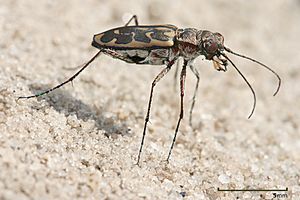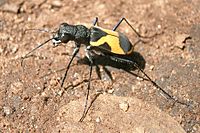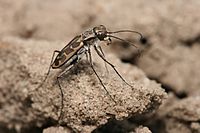Tiger beetle facts for kids
Quick facts for kids Tiger beetle |
|
|---|---|
 |
|
| Lophyra sp in Tanzania | |
| Scientific classification |
|
| Kingdom: | Animalia |
| Phylum: | Arthropoda |
| Class: | Insecta |
| Order: | Coleoptera |
| Superfamily: | Caraboidea |
| Family: | Cicindelidae Latreille, 1802 |
| Tribes | |
|
|
| Synonyms | |
|
|
Tiger beetles are a group of beetles known for being super-fast hunters! They belong to a family called Cicindelidae. These beetles are famous for their quick running and how they catch other insects.
The fastest tiger beetle known is called Rivacindela hudsoni. It can run at an amazing speed of about 9 kilometers per hour (or 5.6 miles per hour). That's like running 125 times its own body length every second! Imagine how fast that is!
As of 2005, scientists knew about 2,600 different kinds of tiger beetles. Most of them live in Asia (the Indo-Malayan region) and South America. For a long time, tiger beetles were thought to be a part of the ground beetles family. But recent studies show they are their own family, Cicindelidae. They are like a close cousin group to the ground beetles.
Contents
What Do Tiger Beetles Look Like?
Tiger beetles often have big, bulging eyes that help them see their prey. They also have long, thin legs for running fast. Their mouths have large, curved mandibles, which are like strong jaws. They use these to grab their food.
Both adult tiger beetles and their young (called larvae) are hunters. They eat other insects.
The Cicindela group of tiger beetles can be found all over the world. Other well-known types include Tetracha, Omus, Amblycheila, and Manticora.
Most Cicindela beetles are active during the day. They can even be seen out on the hottest days! But Tetracha, Omus, Amblycheila, and Manticora beetles are active at night. Many Cicindela and Tetracha beetles have bright, colorful bodies. The other types, like Omus and Manticora, are usually plain black. The Manticora beetles are the biggest in the tiger beetle family. They mostly live in the dry areas of southern Africa.
Tiger Beetle Larvae and Their Habits
The young tiger beetles, called larvae, live in burrows in the ground. These burrows can be as deep as one meter (about 3 feet). The larvae have big heads and a hump on their backs. They use this hump to flip backward. This helps them catch insects that walk over their burrows.
Adult tiger beetles are very fast. They run after their prey to catch it. They can also fly incredibly quickly. Their reaction times are as fast as a common housefly!
Some tiger beetles in warm, tropical places live in trees. But most of them run on the ground. You can find them along the edges of oceans and lakes, on sand dunes, near dry lakebeds, or on clay banks and paths in woodlands. They especially love sandy places.
Tiger beetles are considered a good indicator species. This means they can tell scientists about the health of an environment. They are used in studies about biodiversity, which is the variety of life in a place.
Some types of tiny, wingless wasps, called Methocha wasps, are parasites. They lay their eggs on the larvae of certain Cicindela tiger beetles.
How Tiger Beetles Hunt
Tiger beetles have a special way of hunting. They sprint very fast toward their prey, then stop suddenly. After stopping, they look around to figure out where their prey is again. They do this because they move so fast that their eyes can't see clearly while running.
To avoid bumping into things when they run, they hold their antennae straight out in front of them. This helps them feel their way around. Many tiger beetles hunt in flat, sandy areas. Their eyes are special for this kind of flat world. They have a part of their eye that helps them see clearly along the horizon.
A tiger beetle uses how high its prey appears in its vision to guess how far away it is. Since they hunt by sight, tiger beetles prefer open, flat places. These include sandbars, forest paths, and open scrubland. This way, they can use the height of their prey in their vision to judge distance while chasing it.
Ancient Tiger Beetles: The Fossil Record
The oldest tiger beetle fossil ever found is called Cretotetracha grandis. It was found in China and is about 125 million years old! This fossil dates back to the early Cretaceous Period. Most of these fossils are found in grey or yellow muddy rock.
Scientists know Cretotetracha was a tiger beetle because of its features. It had long, curved jaws (mandibles) like sickles. It also had simple teeth on the inside of its jaws. Its antennae were attached to its head between its eyes and the base of its jaws. The left jaw was about 3.3 millimeters long, and the right jaw was about 4.2 millimeters long. The beetle's body was about 8.1 millimeters long. Its eyes and head together were wider than its chest, and it had long legs for running.
Before this discovery, other ancient tiger beetle fossils were found in Brazil. These included fossils from about 113 million years ago and Oxycheilopsis cretacicus from 112 million years ago.
Tiger Beetle Family Tree
For a long time, tiger beetles were either seen as their own family, Cicindelidae, or as a subgroup of the Carabidae (ground beetles). But since 2020, more and more evidence shows that they should be their own separate family. They are like a sister group to the Carabidae.
Many of the different groups (genera) of tiger beetles we know today came from splitting up the very large Cicindela group. A German scientist named Walther Horn described many of these new groups.
-
A museum example of a Manticora beetle from Mozambique.
-
The rare Salt Creek tiger beetle, Cicindela nevadica lincolniana.
-
Cicindela goryi from India, showing its large eyes and mandibles.
Types of Tiger Beetles (Genera)
- Abroscelis Hope, 1838
- Amblycheila Say, 1829
- Aniara Hope, 1838
- Antennaria Dokhtouroff, 1883
- Apteroessa Hope, 1838
- Archidela Rivalier, 1963
- Baloghiella Mandl, 1981
- Bennigsenium W. Horn, 1897
- Brasiella Rivalier, 1954
- Caledonica Chaudoir, 1860
- Caledonomorpha W. Horn, 1897
- Callidema Guerin-Meneville, 1843
- Callytron Gistl, 1848
- Calomera Motschulsky, 1862
- Calyptoglossa Jeannel, 1946
- Cenothyla Rivalier, 1969
- Cephalota Dokhtouroff, 1883
- Chaetodera Jeannel, 1946
- Cheilonycha Lacordaire, 1843
- Cheiloxya Guerin-Meneville, 1855
- Cicindela Linnaeus, 1758
- Collyris Fabricius, 1801
- Cratohaerea Chaudoir, 1850
- †Cretotetracha Zhao et al., 2019
- Ctenostoma Klug, 1821
- Cylindera Westwood, 1831
- Darlingtonica Cassola, 1986
- Derocrania Chaudoir, 1860
- Diastrophella Rivalier, 1957
- Dilatotarsa Dokhtouroff, 1882
- Distipsidera Westwood, 1837
- Dromica Dejean, 1826
- Dromicoida Werner, 1995
- Dromochorus Guerin-Meneville, 1845
- Ellipsoptera Dokhtouroff, 1883
- Enantiola Rivalier, 1961
- Eunota Rivalier, 1954
- Euprosopus Dejean, 1825
- Euryarthron Guerin-Meneville, 1849
- Eurymorpha Hope, 1838
- Euzona Rivalier, 1963
- Grammognatha Motschulsky, 1850
- Grandopronotalia W. Horn, 1936
- Guineica Rivalier, 1963
- Habrodera Motschulsky, 1862
- Habroscelimorpha Dokhtouroff, 1883
- Heptodonta Hope, 1838
- Hypaetha Leconte, 1860
- †Hujia Song, Jarzembowski and Xiao, 2022
- Iresia Dejean, 1831
- Jansenia Chaudoir, 1865
- Langea W. Horn, 1901
- Leptognatha Rivalier, 1963
- Lophyra Motschulsky, 1859
- Macfarlandia Sumlin, 1981
- Manautea Deuve, 2006
- Mantica Kolbe, 1896
- Manticora Fabricius, 1781
- Megacephala Latreille, 1802
- Megalomma Westwood, 1842
- Metriocheila Thomson, 1857
- Micromentignatha Sumlin, 1981
- Microthylax Rivalier, 1954
- Myriochila Motschulsky, 1862
- Naviauxella Cassola, 1988
- Neochila Basilewsky, 1953
- Neocicindela Rivalier, 1963
- Neocollyris W. Horn, 1901
- Neolaphyra Bedel, 1895
- Nickerlea W. Horn, 1899
- Notospira Rivalier, 1961
- Odontocheila Laporte, 1834
- Omus Eschscholtz, 1829
- Opilidia Rivalier, 1954
- Opisthencentrus W. Horn, 1893
- Orthocindela Rivalier, 1972
- Oxycheila Dejean, 1825
- †Oxycheilopsis Cassola & Werner, 2004
- Oxygonia Mannerheim, 1837
- Oxygoniola W. Horn, 1892
- Paraphysodeutera J. Moravec, 2002
- Pentacomia Bates, 1872
- Peridexia Chaudoir, 1860
- Phaeoxantha Chaudoir, 1850
- Phyllodroma Lacordaire, 1843
- Physodeutera Lacordaire, 1843
- Picnochile Motschulsky, 1856
- Platychile Macleay, 1825
- Pogonostoma Klug, 1835
- Polyrhanis Rivalier, 1963
- Pometon Fleutiaux, 1899
- Prepusa Chaudoir, 1850
- Probstia Cassola, 2002
- Pronyssa Bates, 1874
- Pronyssiformia W. Horn, 1929
- Prothyma Hope, 1838
- Prothymidia Rivalier, 1957
- Protocollyris Mandl, 1975
- Pseudotetracha Fleutiaux, 1894
- Pseudoxycheila Guerin-Meneville, 1839
- Rhysopleura Sloane, 1906
- Rhytidophaena Bates, 1891
- Rivacindela Nidek, 1973
- Ronhuberia J. Moravec & Kudrna, 2002
- Salpingophora Rivalier, 1950
- Socotrana Cassola & Wranik, 1998
- Stenocosmia Rivalier, 1965
- Sumlinia Cassola & Werner, 2001
- Tetracha Hope, 1838
- Therates Latreille, 1816
- Thopeutica Schaum, 1861
- Tricondyla Latreille, 1822
- Vata Fauvel, 1903
- Waltherhornia Olsoufieff, 1934
See also
 In Spanish: Cicindelinos para niños
In Spanish: Cicindelinos para niños







